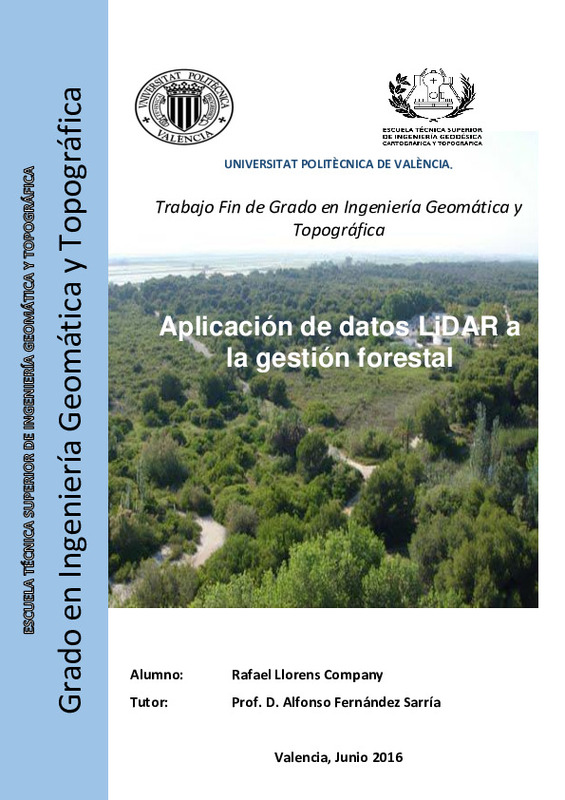|
Resumen:
|
[ES] En el ámbito de la gestión forestal, este trabajo tiene como objetivo crear una metodología de
procesado e integración de datos LIDAR con imágenes multiespectrales para aplicaciones
forestales que requieren una ...[+]
[ES] En el ámbito de la gestión forestal, este trabajo tiene como objetivo crear una metodología de
procesado e integración de datos LIDAR con imágenes multiespectrales para aplicaciones
forestales que requieren una segmentación en rodales.
La zona de estudio se encuentra situada en el Parque Natural de la Albufera de Valencia,
concretamente entre la Devesa del Saler y la Gola de Pujol.
Los datos de partida utilizados son imágenes multiespectrales del satélite Quickbird y datos
LIDAR descargados de la página web del CNIG.
Se utiliza software libre para los procesos correspondientes a la nube de puntos (FUSION y
LASTOOLS) y a la segmentación de los rodales (InterIMAGE). Por otra parte, se utiliza el software
ENVI para las operaciones relacionadas con las imágenes multiespectrales y el software ArcGIS
como software de apoyo y gestión de la información.
En la primera fase del trabajo, se realizan procesos con nubes de puntos tales como recortes,
uniones y filtrados hasta conseguir el modelo digital del terreno (MDT) y el modelo digital de
superficie (MDS). Una vez obtenidos ambos, podemos calcular el modelo digital de vegetación
(MDV o MDSn) donde se representan las alturas de todos los objetos existentes.
En la segunda fase del trabajo, se realizan procesos con imágenes multiespectrales tales como
recortes, cambios de tamaño de píxel, fusión de imágenes por diferentes métodos, análisis de
resultados…
Tras escoger el método de fusión con mayor correlación (imagen que combine la resolución
espacial de la imagen pancromática y la información espectral de las bandas de la imagen
multiespectral), es decir, el método de componentes principales, podemos calcular el Índice de
Vegetación de Diferencia Normalizada (NDVI). Este índice representa información sobre el vigor
vegetativo y sobre el contenido de humedad de la vegetación. En nuestro caso los valores
oscilarán entre -0.011 y 0.540. Valores que cumplen la condición de estar entre -1 y1.
En la tercera fase del trabajo, se realiza sobre el MDV distintas segmentaciones mediante el
software InterIMAGE y utilizando el algoritmo de Baatz & Shape. La última segmentación se
realiza a un archivo resultado de la combinación entre la imagen MDV y la NDVI, cuya solución
es la más precisa de todas al utilizar el índice de vegetación.
Como se indica en las conclusiones finales, esta última segmentación mejora la identificación
de las diferentes cubiertas existentes.
Para finalizar, evaluaremos la segmentación realizada mediante la herramienta FUSION
CloudMetrics y mediante foto interpretación.
Los diferentes resultados indican que la evaluación ha sido correcta ya que cumplen con los
objetivos marcados desde el principio.
[-]
[EN] In the field of forest management, this research has the aim of create a methodology processing
and data integration with LIDAR points and multispectral images for forestry applications
requiring polygon segmentation.
The ...[+]
[EN] In the field of forest management, this research has the aim of create a methodology processing
and data integration with LIDAR points and multispectral images for forestry applications
requiring polygon segmentation.
The study area is located in the Albufera Natural Park of Valencia, specifically between the
Devesa del Saler and the Gola de Pujol.
The input data used are multispectral Quickbird satellite images and LIDAR data downloaded
from the website of CNIG.
Free software will be used for processes corresponding to the point cloud (FUSION and
LASTOOLS) and polygon segmentation (INTERIMAGE). Moreover, the ENVI software will be used
for operations related to the multispectral images and ArcGIS software as software support and
management of the information.
In the first phase of work, there are processes related with point clouds such as trimmings,
unions and filtered until the digital terrain model (DTM) and digital surface model (DSM) are
performed. Once we obtained both digital models, we can calculate the model digital model of
vegetation (CHM or DSMn) where the heights of all existing objects are represented.
In the second phase of work, there are multispectral imaging processes such as trimmings, pixel
resizes, image fusion by different methods, analysis of results...
After choosing the method of fusion with higher correlation (image that combines the spatial
resolution of the panchromatic image and spectral information of multispectral image bands),
in this case Principal Components method, we can calculate the Normalized Differential
Vegetation Index (NDVI). This index represents information on the vegetative vigor. In our case,
these values are right because they are inside -1 and 1 range
In the third phase of work, we will be realized different segmentations to CHM image with
INTERIMAGE software and using the Baatz & Shape algorithm.
The final segmentation will be performed to a file result of the combination between CHM and
DMV image, which solution will be the most accurate.
As indicated in final conclusions, the last segmentation will improve the identification of
different existing decks.
Finally, we will evaluate this segmentation by FUSION tool CloudMetrics and by photointerpretation.
Different results indicate that the evaluation was successful because they meet the objectives
mentioned at the beginning.
[-]
|







